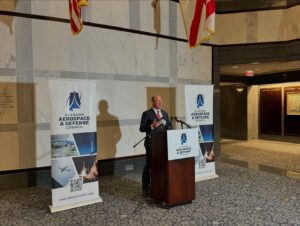Randall Woodfin celebrates pro-football franchise coming to Birmingham

Birmingham, Ala. will soon be the new home of a new, yet-to-be-named professional football team franchise. The Alliance of American Football (AAF) announced the decision on Monday to include Birmingham as part of a new eight-team league, which will start a twelve-week season starting in February of 2019, culminating in a championship game in April of 2019. Birmingham Mayor Randall Woodfin shared his excitement over the announcement via Facebook by sharing a video of Mike Vick welcoming the city to the alliance. “Welcome to Birmingham AAF! Excited to hit the field with you! #AllianceBirmingham.,” Woodfin posted. Other teams in the league include: Atlanta, Memphis, Orlando, Phoenix, San Diego and Salt Lake City. The Birmingham team will play its first two seasons at legion field, then move to the new stadium planned for the Birmingham-Jefferson Convention Complex (BJCC), according to the Birmingham Business Journal. A head coach has not been selected for the team, but the league is expected to make further announcements later this week regarding all the details of the team. With a pro-football team coming to the city, the controversial decision made by the Birmingham City Council in March to invest $90 million over the next 30 years to renovate the BJCC and construct of a new downtown stadium, doesn’t look so terrible. However, Birmingham has experienced problems in the past, of getting professional football leagues to hold. The city has been home to several leagues over the past 20 years, and while many developed a notable fan base in the area, the teams “ultimately couldn’t overcome financial or other challenges that come with trying to compete in the shadow of the NFL and college football,” according to the Birmingham Business Journal.
Daniel Sutter: Pro football in the spring again

Spring professional football returns in 2019 with the Alliance of American Football (AAF). I am very excited about this and think that the league has an excellent chance to be successful. The AAF’s potential also illustrates one of economics’ most difficult challenges. The Alliance’s eight teams will play a ten game season beginning after the Super Bowl. The AAF’s founders have great sports backgrounds: Charlie Ebersol is the son of long-time NBC Sports President Dick Ebersol, while Bill Polian was General Manager of three NFL teams. The Alliance will offer a partnership with the players and features former NFL players Troy Polamalu, Hines Ward, and Jared Allen in executive positions. The Alliance will feature some innovative rules, like only two point conversions after touchdowns. In place of dangerous kickoffs, teams will take possession on their own 25-yard line. Instead of on-sides kicks, a team can take the ball with fourth and ten on their own 35-yard line. Fantasy football will be promoted extensively. Steve Spurrier and Brad Childress will coach the teams in Orlando and Atlanta. The league will own the teams, which should allow maintenance of salaries consistent with projected revenue. Salaries will be well below the NFL’s average of $1.9 million. But attracting players should not be a problem; Canadian Football League fills its rosters with an average salary of around $80,000. As only about 2 percent of college players make the NFL, many recognizable players will be available. Many football fans find themselves in withdrawal after the Super Bowl, with the next games seven months away. Add in fantasy players and sports bettors, and the market seems available. The Alliance gives football junkies something to talk about, but what does this have to do with economics? It illustrates a critical and controversial element of economic performance. Spring pro football sounds like a great and profitable idea. But if spring football is such a great idea, why hasn’t it been tried since the United States Football League’s last spring season nearly 35 years ago? If I am right about the AAF’s prospects, then investors have been missing out on profits, fans on entertainment, and players on opportunity. In other words, the market has failed to deliver something of value. The fundamental question in economics is whether free markets or activist government provides the better path to prosperity. And the potential inefficiency in markets arises from products and services not available. The items businesses provide every day almost certainly create value, because customers will only repeatedly buy products they find worth the price, while firms won’t continue to sell at a loss. But would products and services which are not available provide value for the economy? Establishing conclusively that any product not available would make us better off is extremely hard. To see why, consider spring football. The idea must have occurred to investors, since the USFL, Arena Football, and Vince McMahon’s XFL all played spring and summer games. Investors may have explored the idea and identified challenges I do not see. I have never started a business, so professional investors should be more likely to see potential problems than me. Given the potential challenges, the AAF’s success may be far less certain than I think. Everybody probably has an idea for a new product or service that would make a fortune. As criticisms of the market, most of these claims are really like Monday morning quarterbacking. Further, the claims also invite a challenge: if I were sure that spring football was a “can’t miss” deal, I could invest in the AAF. Yet this well-founded skepticism of great products not available easily bleeds into ideological certainty that markets always provide all valuable new products. Spring football is returning. As a football fan, I am bullish on the Alliance’s prospects, but the economist in me remains cautious. If the league is successful, then we should ask why this didn’t happen years ago. And that will be an important economic question. ••• Daniel Sutter is the Charles G. Koch Professor of Economics with the Manuel H. Johnson Center for Political Economy at Troy University and host of Econversations on TrojanVision. The opinions expressed in this column are the author’s and do not necessarily reflect the views of Troy University.


